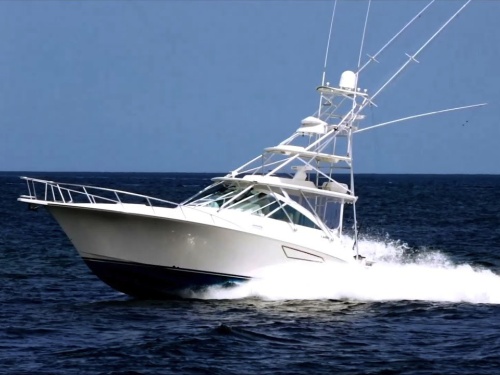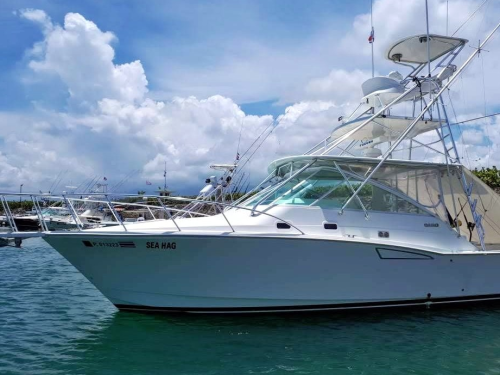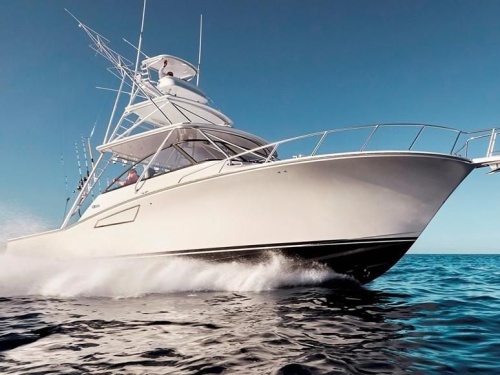Access More Boat Tests
Already have an account? Login
Cabo 32 Express (2010-)
Brief Summary
The Cabo 32 is an offshore fighting machine designed and built by fishermen for fishermen. Even though she measures only 32’10” (10.10 m) she is 13’3” (4.07 m) wide and displaces a hefty 19,100 lbs. (8,681 kgs.). That’s a beam/length ratio of 40%! That’s something that you rarely see in any size boat, and it means she has a larger cockpit, wider bridge deck, and more spacious interior than any boat in her class. It also means that you have 360-degree access around her twin diesel engines, something that is problematical in many boats her size. If you have been thinking about a big convertible or large express fishboat but are in shock and awe of the price tags, then take our advice and give the Cabo 32 some consideration.
Specifications
| Length Overall | 35' 0'' / 10.7 m |
|---|---|
| Beam |
13' 3'' 4.03 m |
| Dry Weight |
19,100 lbs. 8,663 kg |
| Draft |
2' 8'' 0.81 |
| Deadrise/Transom | 17.5 deg. |
| Max Headroom |
6' 6'' 1.98 m |
| Bridge Clearance | N/A |
| Fuel Capacity |
350 gal. 1,325 L |
| Water Capacity |
50 gal. 189 L |
Engine Options
| Tested Engine |
Currently no test numbers |
|---|---|
| Std. Power |
Not Available |
| Opt. Power |
Twin Caterpillar C7 ACERT, 461 HPM Twin Cummins QSB5.9, 425 HPM Twin Cummins QSB5.9, 480 HPM Twin Yanmar 6LY3A-ETP, 480 HPM Twin Yanmar 6LY3A-STP, 440 HPM |
Captain's Report
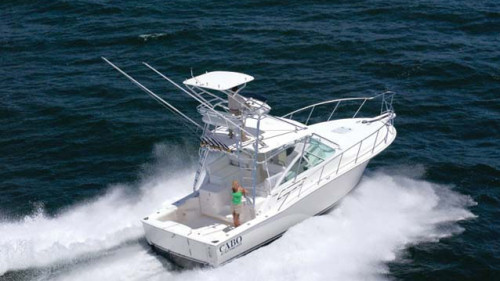
The Mission
The Cabo 32 Express is the smallest boat that Cabo makes. Nevertheless it has packed into it most of the fishing amenities, equipment and gear that one might find on its larger models. That is because the mission of the Cabo 32 is just about the same as it is for its larger boats – to be able to go offshore and provide a capable platform to raise and land game fish and accommodate anglers and guests both on deck and below in comfort and safety. She has the fuel capacity to go out to the canyons 100 miles offshore, spend the better part of a day trolling, and return on a load of fuel.
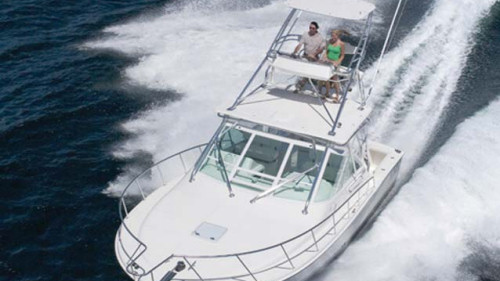
Major Attributes
* Perhaps the major attribute of the Cabo 32 is the fact that the builder makes only fishing boats, 13 models from 32’ to 52’. That means that the company’s staff is intensely focused in building rugged boats for demanding, salty fishermen. This is a serious angler’s boat. We would say that it is a “man’s boat”, but in fact, there are many serious female anglers on the circuit, too, and they will appreciate the boat just as much.
* As already noted above, the boat’s 13’3” (4.07 m) beam is greatest in class. We had to go all the way up to a 35-footer to find another boat with this beam. This attribute pays off all over the boat in many ways in terms of room and access in the engine room.
* The Cabo 32 is also one of the most stable boats in class offshore when trolling. Its wide beam combined with its 17.5-degree dead rise resists rolling far more than will a typical deep-V. It is also the second-heaviest boat in class at 19,100 lbs. (8,681 kgs.), 2,000-5,000 lbs. (909-2,272 kgs.) more than most in class.
* The boat has 6’6” (2.0 m) head room below.
The Engine Room
Cabo makes five diesel engine options available in the 32 from three different engine makers: Cat, Cummins, and Yanmar. Horsepower among these five options run from twin 425 mills to twin 480s. While we haven’t tested the boat, our guess is that the boat will cruise comfortably in the mid-20s to mid-30 knot range, depending on engines selected.
The Cabo carries 350 gallons of fuel which is typical of most boats in class. Her beam, however, means that her engine room is going to be superior to most others in class simply because it is possible to easily get all around its engines and to access all important equipment in the engine room.
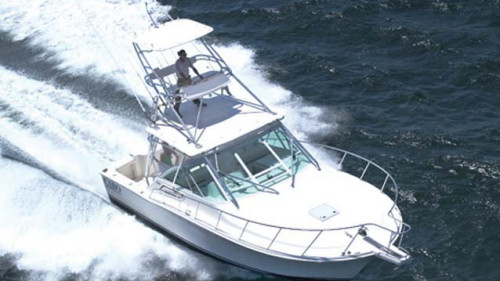
Like most boats in this range, the engine room is under the bridge deck, which typically rises automatically at the push of a button. But here the boat brands diverge. We urge any buyer of a boat in this class to actually get into the engine room of any boat they are considering. We have often been astonished as to how restricted access is to important filters and other equipment in some boats. On occasion we have been appalled that builders would take a boat to a boat show when the bridge deck didn’t even open properly.
Finally, the engine room interior surfaces are all either gel coated or painted with polyurethane paint. This is an important detail.
Construction
The Cabo 32 hull is made of vinylester resin and biaxial fiberglass cloth. While virtually all boats in class these days have a layer or two of vinylester resin (to eliminate blistering), only those that vacuum bag their hull laminates use only 100% vinylester resin. This is important because it is stronger, impervious to water migration, and in combination with the vacuum bagging process, lighter than conventional layups using polyester resin, which is far cheaper. Because of the infusion process, the hulls can’t be part vinylester resin and part polyester resin. So these hulls cost more to build.
Cabo does something that is somewhat unusual in boats of this class: it bonds the fiberglass inner liner to the inside of the hull. Cabo claims that this strengthens the hull, reducing flexing and wracking in rough offshore conditions.
Cabo is proud of the way that it handles its electrical systems and the way it makes figuring them out user friendly. Certainly the color-coded wires, backlit electrical panels, and anti-chafing material placed everywhere wires can abrade are important features.
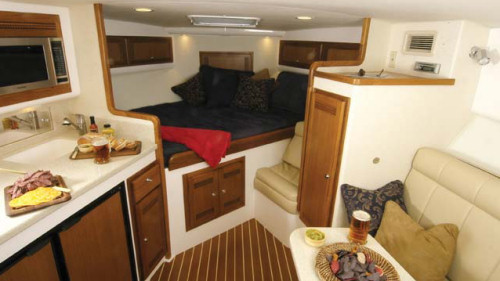
Accommodations
On the bridge deck there are two, wide bench seats, port and starboard. We like the fact that four people can sit looking comfortably forward. When running out to the fishing grounds this is the most comfortable way to ride, and four sets of eyes looking forward instead of just one to three is a lot better. Note that there are two fore and aft bench seats abaft the forward-facing ones. This is a good place for anglers to sit when trolling and be in the shade of the hard top.
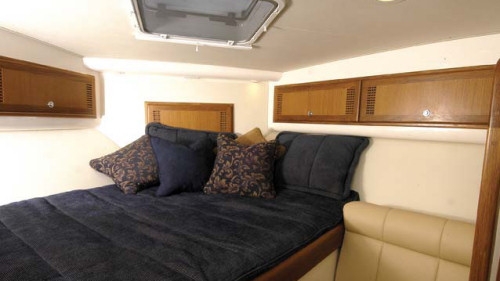
Below decks the Cabo 32 has a double berth in the bow and the settee on the starboard side converts into a berth plus a Pullman. The disadvantages to a double berth are obvious – when nature calls the person on the inside will disturb the one on the outside, the bunk is hard to make up, and if you have four men to sleep someone might feel uncomfortable. On the other hand, remember that this is only a 32’ boat. Someone can sleep on the cabin sole.
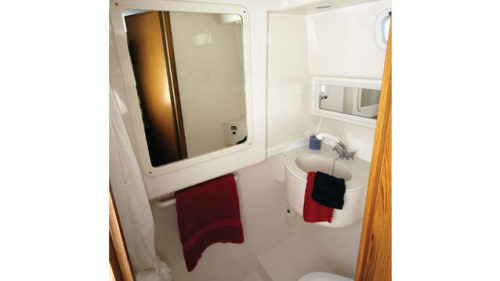
There is 6’6” (2 m) headroom and because of the beam there is more room than in most boats in class below. The shower is in the head compartment and there is a seat next to the double bunk forward so you have a place to sit when putting on your topsiders.
Fishability
All boats in class have pretty much the same fishing attributes. Because the Cabo 32 is a purpose-built boat there might be fewer compromises than one might find on the fisher/cruisers. A couple of things strike us as noteworthy: the transom door swings out (as it should for fast dewatering of the cockpit), and it has a gate that covers the top to keep someone from falling out; there is a bait prep center like real fishing boats had in the good old days before mezzanine seating became the rage. We prefer the way Cabo has done it on their 32, i.e. putting spectator seating on the bridge deck. Obviously the ample beam comes in handy during the mad rush when all hands are reeling in baits when there has been a hook up.
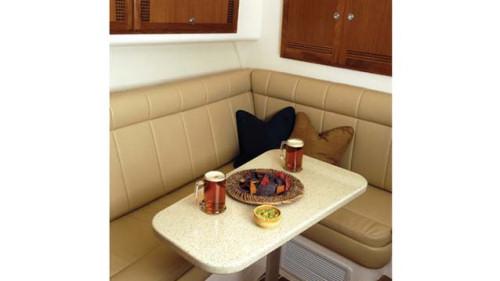
Recommendation
There are about a dozen express cruisers in the low 30-foot range made by “known” builders, plus a few built by folks that are not known outside of their home area. Most all are fishermen or have salty fishy types on staff so at first glance most of the boats look pretty good. Our advice is that buyers take a good look at the details, taking each of the areas of the boat one at a time and compare and evaluate them. For example, the cockpit, the bridge deck, the engine room, and accommodations should all be compared on their individual merits.
Construction and fit and finish are important considerations. Someday the boat will end up on the used boat market. The better a boat is built and the better it looks now, the more it will fetch on the used boat market.
Make sure that the mechanics of lifting the bridge deck to get to the engine room works well. They are not all designed the same and we have been surprised at what we have found on boats from time to time in this class over the years. Engine room access in this size and design is often problematical so be sure to check to boats on you short list for this attribute.
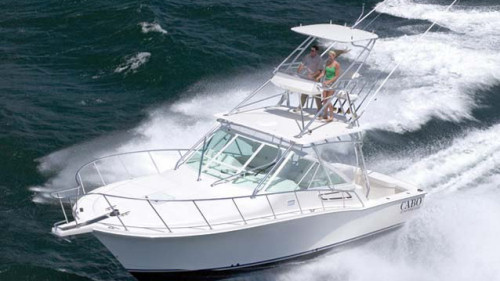
Finally, you have to judge the aspects of the boat that are the hardest to evaluate and compare. The ride is important both when trolling and when crashing out to the fishing grounds. Since we have not tested this boat we can give no guidance other than what has been mentioned above.
Equally important is how a buyer perceives the brand and the specific model being considered. This is an intangible and one that is impossible for us to offer guidance on other than to say be aware of its importance. Buying for price alone, or just because one got a great deal, or because the salesman had the most winning personality, or it was the only boat available the weekend the buying bug bit, all fade pretty fast for most boat owners we know.

